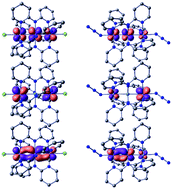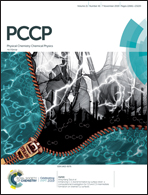How to understand very weak Cr–Cr double bonds and negative spin populations in trinuclear Cr complexes: theoretical insight†
Abstract
Trinuclear Cr(II) complex [Cr3(dpa)4Cl2] 1 (Hdpa = dipyridylamine) has two Cr–Cr double bonds linked with each other. DMRG-CASPT2 calculations reproduced its symmetrical structure. The Cr–Cr effective bond order (EBO) was evaluated to be only 0.59 based on the density matrix based on localized orbitals from DMRG-CASSCF orbitals. The CASCI calculations showed a significantly large α-spin population on the terminal Cr atoms as expected but a significantly large β-spin population on the central Cr atom against expectations. The very small EBO and the presence of a large β-spin population are not consistent with the simple understanding that 1 has two Cr–Cr double bonds and a quintet ground state, which requests correct understanding of 1 from the viewpoint of chemical bond theory. Comparison of 1 with the allene molecule and allyl radical disclosed that the linked Cr–Cr bonds of 1 resembled the C–C bond of the allyl radical but completely differed from the linked C–C double bonds of allene despite the similar molecular structure. Its N3 analogue [Cr3(dpa)4(N3)2] 2 has non-symmetrical structure with shorter Cr1–Cr2 and longer Cr2–Cr3 bonds unlike 1, indicating that 2 is a valence tautomer of 1. DMRG-CASPT2 could reproduce its non-symmetrical structure but DFT/B3PW91 could not. In 2, the EBO is 0.95 for the shorter Cr1–Cr2 bond and 0.47 for the longer Cr2–Cr3 one. The terminal Cr3 has a very large α spin population, and the other terminal Cr1 has a somewhat large α spin population, but the central Cr2 has a considerably large β spin population. These results indicate that the Cr1–Cr2 bond conjugates with the Cr2–Cr3 bond, which is inconsistent with the simple understanding that 2 has a quadruple bond between Cr1 and Cr2 and no bond between Cr2 and Cr3. The symmetrical structure has a stronger Cr–X coordinate bond (X = Cl or N3) but less stable Cr3 core than does the non-symmetrical one. The relative stabilities of the symmetrical and the non-symmetrical structures are determined by the balance between stabilization energies from the Cr3 core and the Cr–X coordinate bond. All these findings show that electronic structures and Cr–Cr bonds of 1 and 2 are interesting from the viewpoint of molecular science.



 Please wait while we load your content...
Please wait while we load your content...